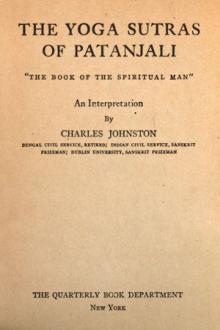An Introduction to Yoga by Annie Besant (recommended reading .TXT) 📖

- Author: Annie Besant
- Performer: 8170590507
Book online «An Introduction to Yoga by Annie Besant (recommended reading .TXT) 📖». Author Annie Besant
States of Mind
Let us take it in detail. Four states of consciousness are spoken of amongst us. “Waking” consciousness or Jagrat; the “dream”
consciousness, or Svapna; the “deep sleep” consciousness, or Sushupti; and the state beyond that, called Turiya[FN#3: It is impossible to avoid the use of these technical terms, even in an introduction to Yoga. There are no exact English equivalents, and they are no more troublesome to learn than any other technical psychological terms.] How are those related to the body?
Jagrat is the ordinary waking consciousness, that you and I are using at the present time. If our consciousness works in the subtle, or astral, body, and is able to impress its experiences upon the brain, it is called Svapna, or in English, dream consciousness; it is more vivid and real than the Jagrat state.
When working in the subtler form—the mental body—it is not able to impress its experiences on the brain, it is called Sushupti or deep sleep consciousness; then the mind is working on its own contents, not on outer objects. But if it has so far separated itself from connection with the brain, that it cannot be readily recalled by outer means, then it is, called Turiya, a lofty state of trance. These four states, when correlated to the four planes, represent a much unfolded consciousness. Jagrat is related to the physical; Svapna to the astral; Sushupti to the mental; and Turiya to the buddhic. When passing from one world to another, we should use these words to designate the consciousness working under the conditions of each world. But the same words are repeated in the books of Yoga with a different context. There the difficulty occurs, if we have not learned their relative nature.
Svapna is not the same for all, nor is Sushupti the same for everyone.
Above all, the word samadhi, to be explained in a moment, is used in different ways and in different senses. How then are we to find our way in this apparent tangle? By knowing the state which is the starting-point, and then the sequence will always be the same. All of you are familiar with the waking consciousness in the physical body. You can find four states even in that, if you analyse it, and a similar sequence of the states of the mind is found on every plane.
How to distinguish them, then ? Let us take the waking consciousness, and try to see the four states in that. Suppose I take up a book and read it. I read the words; my eyes arc related to the outer physical consciousness. That is the Jagrat state. I go behind the words to the meaning of the words. I have passed from the waking state of the physical plane into the Svapna state of waking consciousness, that sees through the outer form, seeking the inner life. I pass from this to the mind of the writer; here the mind touches the mind; it is the waking consciousness in its Sushupti state. If I pass from this contact and enter the very mind of the writer, and live in that man’s mind, then I have reached the Turiya state of the waking consciousness.
Take another illustration. I look at any watch; I am in Jagrat. I close my eyes and make an image of the watch; I am in Svapna. I call together many ideas of many watches, and reach the ideal watch; I am in Sushupti. I pass to the ideal of time in the abstract; I am in Turiya. But all these are stages in the physical plane consciousness; I have not left the body.
In this way, you can make states of mind intelligible and real, instead of mere words.
Samadhi
Some other important words, which recur from time to time in the Yoga-sutras, need to be understood, though there are no exact English equivalents. As they must be used to avoid clumsy circumlocutions, it is necessary to explain them. It is said: “Yoga is Samadhi.” Samadhi is a state in which the consciousness is so dissociated from the body that the latter remains insensible. It is a state of trance in which the mind is fully self-conscious, though the body is insensitive, and from which the mind returns to the body with the experiences it has had in the superphysical state, remembering them when again immersed in the physical brain. Samadhi for any one person is relative to his waking consciousness, but implies insensitiveness of the body. If an ordinary person throws himself into trance and is active on the astral plane, his Samadhi is on the astral. If his consciousness is functioning in the mental plane, Samadhi is there. The man who can so withdraw from the body as to leave it insensitive, while his mind is fully self-conscious, can practice Samadhi.
The phrase “Yoga is Samadhi” covers facts of the highest significance and greatest instruction. Suppose you are only able to reach the astral world when you are asleep, your consciousness there is, as we have seen, in the Svapna state. But as you slowly unfold your powers, the astral forms begin to intrude upon your waking physical consciousness until they appear as distinctly as do physical forms, and thus become objects of your waking consciousness. The astral world then, for you, no longer belongs to the Svapna consciousness, but to the Jagrat; you have taken two worlds within the scope of your Jagrat consciousness—the physical and the astral worlds—and the mental world is in your Svapna consciousness. “Your body” is then the physical and the astral bodies taken together. As you go on, the mental plane begins similarly to intrude itself, and the physical, astral and mental all come within your waking consciousness; all these are, then, your Jagrat world. These three worlds form but one world to you; their three corresponding bodies but one body, that perceives and acts. The three bodies of the ordinary man have become one body for the yogi. If under these conditions you want to see only one world at a time, you must fix your attention on it, and thus focus it. You can, in that state of enlarged waking, concentrate your attention on the physical and see it; then the astral and mental will appear hazy. So you can focus your attention on the astral and see it; then the physical and the mental, being out of focus, will appear dim. You will easily understand this if you remember that, in this hall, I may focus my sight in the middle of the hall, when the pillars on both sides will appear indistinctly. Or I may concentrate my attention on a pillar and see it distinctly, but I then see you only vaguely at the same time. It is a change of focus, not a change of body. Remember that all which you can put aside as not yourself is the body of the yogi, and hence, as you go higher, the lower bodies form but a single body and the consciousness in that sheath of matter which it still cannot throw away, that becomes the man.
“Yoga is Samadhi.” It is the power to withdraw from all that you know as body, and to concentrate yourself within. That is Samadhi. No ordinary means will then call you back to the world that you have left.[FN#4: An Indian yogi in Samadhi, discovered in a forest by some ignorant and brutal Englishmen, was so violently ill used that he returned to his tortured body, only to leave it again at once by death.] This will also explain to you the phrase in The Secret Doctrine that the Adept ” begins his Samadhi on the atmic plane ” When a Jivan-mukta enters into Samadhi, he begins it on the atmic plane. All planes below the atmic are one plane for him. He begins his Samadhi on a plane to which the mere man cannot rise. He begins it on the atmic plane, and thence rises stage by stage to the higher cosmic planes. The same word, samadhi, is used to describe the states of the consciousness, whether it rises above the physical into the astral, as in self-induced trance of an ordinary man, or as in the case of a Jivan-mukta when, the consciousness being already centred in the fifth, or atmic plane, it rises to the higher planes of a larger world.
The Literature of Yoga
Unfortunately for non-Sanskrit-knowing people, the literature of Yoga is not largely available in English. The general teachings of Yoga are to be found in the Upanishads, and the Bhagavad-Gita; those, in many translations, are within your reach, but they are general, not special; they give you the main principles, but do not tell you about the methods in any detailed way. Even in the Bhagavad-Gita, while you are told to make sacrifices, to become indifferent, and so on, it is all of the nature of moral precept, absolutely necessary indeed, but still not telling you how to reach the conditions put before you. The special literature of Yoga is, first of all, many of the minor Upanishads, “the hundred-and-eight” as they are called. Then comes the enormous mass of literature called the Tantras. These books have an evil significance in the ordinary English ear, but not quite rightly.
The Tantras are very useful books, very valuable and instructive; all occult science is to be found in them. But they are divisible into three classes: those that deal with white magic, those that deal with black magic, and those that deal with what we may call grey magic, a mixture of the two. Now magic is the word which covers the methods of deliberately bringing about super-normal physical states by the action of the will.
A high tension of the nerves, brought on by anxiety or disease, leads to ordinary hysteria, emotional and foolish. A similarly high tension, brought about by the will, renders a man sensitive to superphysical vibrations Going to sleep has no significance, but going into Samadhi is a priceless power. The process is largely the same, but one is due to ordinary conditions, the other to the action of the trained will. The Yogi is the man who has learned the power of the will, and knows how to use it to bring about foreseen and foredetermined results. This knowledge has ever been called magic; it is the name of the Great Science of the past, the one Science, to which only the word ” great “
was given in the past. The Tantras contain the whole of that; the occult side of man and nature, the means whereby discoveries may be made, the principles whereby the man may re-create himself, all these are in the Tantras. The difficulty is that without a teacher they are very dangerous, and again and again a man trying to practice the Tantric methods without a teacher makes himself very ill. So the Tantras have got a bad name both in the West and here





Comments (0)